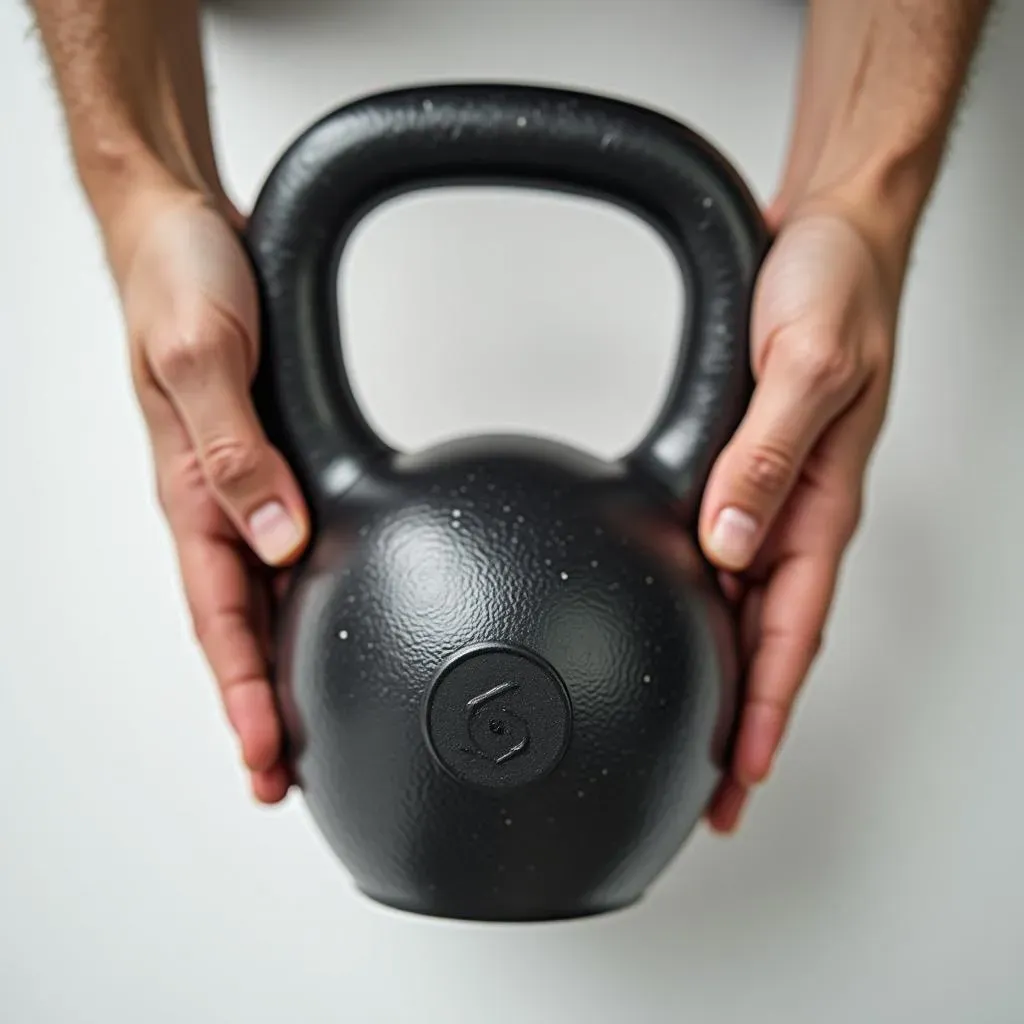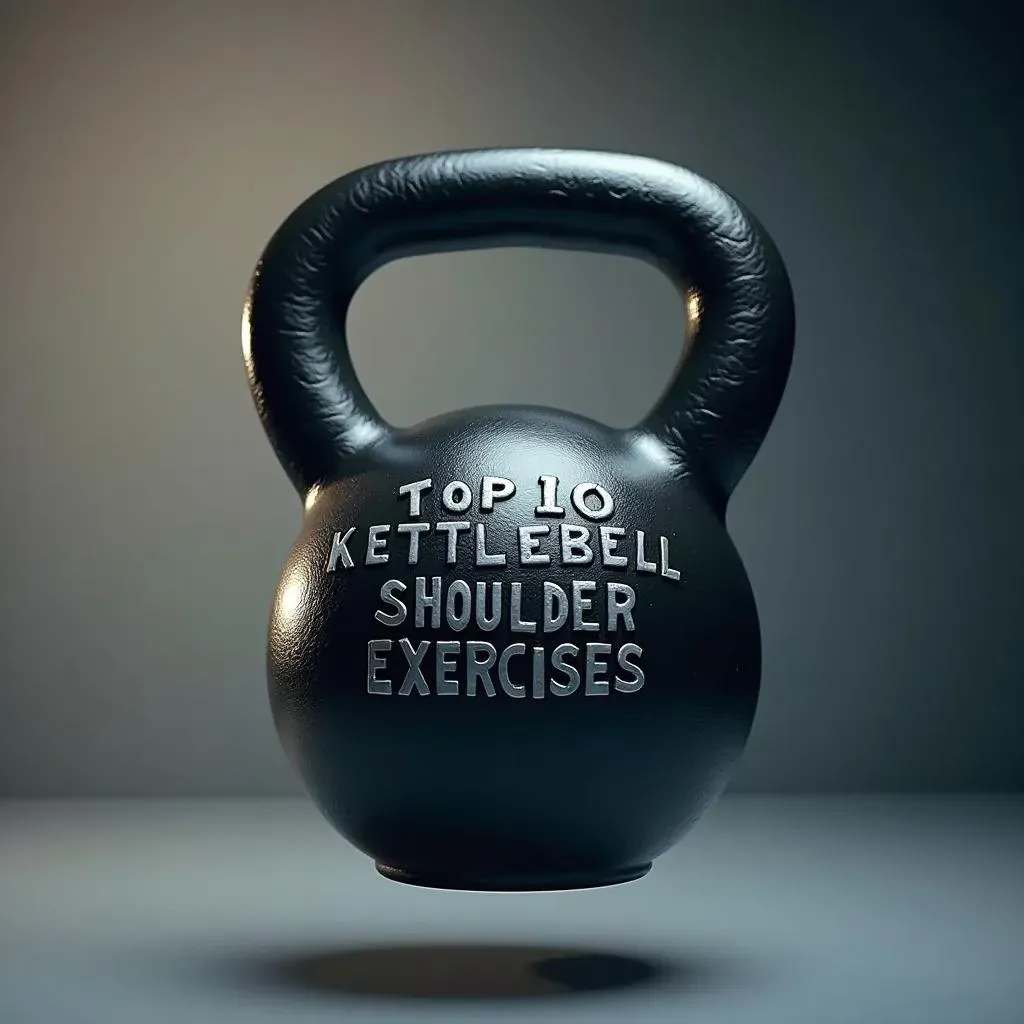Table of Contents
Want shoulders that are strong, stable, and injury-resistant? You've come to the right place. The shoulder is a complex joint, requiring both mobility and stability to function optimally. That's why diving into shoulder exercises without a plan can lead to problems. This article will guide you through the **best kettlebell shoulder exercises**, carefully selected and ordered to help you build a solid foundation and progress safely. We'll start with exercises that focus on stabilizing the shoulder joint before moving into more dynamic and challenging movements. Think of it like building a house. You wouldn't start putting up walls before laying a foundation, right? Similarly, you need to strengthen the smaller, stabilizing muscles around your shoulder before loading up with heavy weights. We'll cover everything from foundational holds to advanced pressing variations, ensuring you're hitting all the right muscles and moving with proper form. Get ready to unlock your shoulder strength and prevent future injuries with this comprehensive guide to kettlebell training.
Kettlebell Exercises for Shoulder Stability: The Foundation

Kettlebell Exercises for Shoulder Stability: The Foundation
Before you even think about pressing heavy kettlebells overhead, you've got to nail the foundation of shoulder stability. Think of your shoulder joint like a golf ball sitting on a tee – it's inherently unstable. The muscles and tissues surrounding it need to work together to keep that ball centered and moving smoothly. That's where these foundational kettlebell exercises come in. They're not about building massive deltoids; they're about waking up the smaller, often-neglected muscles that protect your shoulder joint from injury. We are talking about your rotator cuff, your scapular stabilizers – the unsung heroes of shoulder health. Neglecting these muscles is like skipping leg day, eventually, it's gonna catch up to you.
Why is this so important? Because when those stabilizers are weak, your bigger muscles (like your deltoids and traps) try to compensate. This can lead to imbalances, pain, and eventually, injury. Kettlebells are fantastic for building this kind of stability because they challenge your body in unique ways. The offset weight forces your muscles to work harder to control the movement, which translates to stronger, more resilient shoulders. So, before you jump into the flashy stuff, commit to mastering these foundational exercises. Your shoulders will thank you for it.
Which exercises are we talking about? We're talking about movements that emphasize control, proper form, and mindful engagement of the right muscles. Think slow and steady, not fast and furious. Focus on feeling the muscles working, and don't be afraid to drop the weight if you can't maintain good form. Your ego can wait; your shoulders can't.
Top 10 Best Kettlebell Shoulder Exercises: A Progressive Guide

Top 10 Best Kettlebell Shoulder Exercises: A Progressive Guide
Alright, now for the main course: the **top 10 best kettlebell shoulder exercises**, presented in a progressive order. This isn't just a random list; it's a carefully curated sequence designed to build strength, stability, and resilience in your shoulders. We're starting with the basics and gradually increasing the difficulty, so you can safely and effectively challenge yourself. Each exercise builds upon the previous one, preparing you for the next level of intensity. Remember, it's not a race. Master each exercise before moving on to the next. Your shoulders will thank you for your patience and dedication.
So, what are these magical exercises? We're talking about everything from static holds that build isometric strength to dynamic movements that improve coordination and power. You'll find exercises that target different parts of your shoulder, ensuring a well-rounded approach to training. And, of course, we'll be emphasizing proper form and technique every step of the way. Because let's be honest, there's no point in doing an exercise if you're not doing it right. Ready to dive in? Let's get started.
Exercise # | Exercise Name | Focus |
|---|---|---|
1 | Straight Arm Overhead Kettlebell Hold | Isometric Stability |
2 | Kettlebell Windmill | Mobility & Core Stability |
3 | Kettlebell Turkish Get Up | Full-Body Coordination & Stability |
4 | Kettlebell Shoulder Push Press | Overhead Power & Stability |
5 | Kettlebell Thruster (Squat & Shoulder Press) | Full-Body Strength & Conditioning |
6 | Kettlebell Sit and Press | Core Engagement & Shoulder Stability |
7 | Kettlebell Clean and Press | Full Body Power & Coordination |
8 | Kettlebell Shoulder Press | Strict Overhead Strength |
9 | Kettlebell Half Kneeling Press | Unilateral Strength & Stability |
10 | Kettlebell Bottoms Up Press | Advanced Stability & Control |
Now, let's break down each of these exercises in detail, shall we?
Kettlebell Shoulder Workout: Integrating Exercises for Results

Kettlebell Shoulder Workout: Integrating Exercises for Results
Designing Your Kettlebell Shoulder Routine
so you've got the individual exercises down. Now comes the fun part: weaving them together into a killer **kettlebell shoulder workout**! But before you start swinging, let's talk strategy. You wouldn't just throw a bunch of ingredients into a pot and hope for a gourmet meal, would you? Same goes for your workout. You need a plan, a purpose, and a progression. Start by assessing your current fitness level and identifying your goals. Are you trying to build strength, improve stability, or increase endurance? Your answers will dictate the exercises you choose and the way you structure your workout.
A good starting point is to select 3-4 exercises from the list above, focusing on a mix of stability and strength movements. For example, you could combine the Straight Arm Overhead Hold, Kettlebell Windmill, and Kettlebell Shoulder Press. Perform each exercise for 3 sets of 8-12 repetitions, resting for 60-90 seconds between sets. As you get stronger, you can increase the weight, the reps, or the number of sets. Remember, consistency is key. Aim to perform your kettlebell shoulder workout 2-3 times per week, allowing for adequate rest and recovery between sessions.
Sample Kettlebell Shoulder Workout Structures
Need some inspiration? Here are a couple of sample **kettlebell shoulder workout** structures to get you started. Remember to adjust the weight and reps to match your fitness level.
Workout A: Stability Focus
- Straight Arm Overhead Kettlebell Hold: 3 sets of 30-60 seconds
- Kettlebell Windmill: 3 sets of 8-12 reps per side
- Kettlebell Turkish Get Up: 3 sets of 1-3 reps per side
- Kettlebell Half Kneeling Press: 3 sets of 8-12 reps per side
Workout B: Strength Focus
- Kettlebell Shoulder Press: 3 sets of 8-12 reps
- Kettlebell Push Press: 3 sets of 6-10 reps
- Kettlebell Clean and Press: 3 sets of 5-8 reps
- Kettlebell Bottoms Up Press: 3 sets of 3-5 reps per side
Progressing Your Kettlebell Shoulder Training
Don't get stuck in a rut! As you get stronger and more comfortable with the exercises, it's important to progressively overload your muscles to continue seeing results. This means gradually increasing the demands on your body over time. There are several ways to do this.
Here's a few ways to keep challenging your shoulder:
- Increase the weight: This is the most obvious way to progress. As the weight feels easier, grab a heavier kettlebell.
- Increase the reps: If you can easily perform the prescribed number of reps with good form, add a few more.
- Increase the sets: Adding an extra set or two can increase the overall volume of your workout.
- Decrease the rest time: Shortening the rest periods between sets can increase the intensity of your workout.
- Change the exercise: As you master an exercise, progress to a more challenging variation.
Avoiding Injury: Proper Form in Kettlebell Shoulder Training

Avoiding Injury: Proper Form in Kettlebell Shoulder Training
Listen to Your Body: The First Rule of Kettlebell Club
Let's be real, ego lifting is a recipe for disaster, especially when it comes to your shoulders. Trying to hoist a weight that's too heavy or pushing through pain is a surefire way to end up sidelined. **Avoiding injury** starts with listening to your body and respecting its limits. That twinge in your shoulder? Don't ignore it. Scale back the weight, modify the exercise, or take a rest day. There's no shame in admitting that you're not feeling 100%. In fact, it's a sign of intelligence. Remember, consistency trumps intensity every time. A long, healthy training career is far more rewarding than a short, painful one.
And it's not just about the weight you're lifting. It's also about the way you're moving. Are you rushing through the exercises, sacrificing form for speed? Are you compensating with other muscle groups to get the weight up? These are all red flags that you need to slow down and focus on proper technique. Think of each rep as an opportunity to refine your form and strengthen your mind-muscle connection. The more mindful you are, the less likely you are to get injured.
Mastering the Fundamentals: The Key to Shoulder Longevity
Before you even think about attempting advanced kettlebell exercises, you need to master the fundamentals. I'm talking about the basic movements like the kettlebell swing, clean, and goblet squat. These exercises build a foundation of strength, stability, and coordination that will carry over to your shoulder training. If you can't perform these movements with proper form, you have no business trying to press heavy kettlebells overhead. It's like trying to build a skyscraper on a shaky foundation – it's only a matter of time before it collapses.
Pay close attention to your posture and alignment during these exercises. Keep your core engaged, your back straight, and your shoulders packed down and back. Avoid rounding your spine or shrugging your shoulders. These are common mistakes that can put unnecessary stress on your shoulder joint. If you're unsure about your form, seek guidance from a qualified kettlebell instructor or physical therapist. They can help you identify and correct any faulty movement patterns before they lead to injury.
Movement | Key Form Cue | Why It Matters |
|---|---|---|
Kettlebell Swing | Hinge at the hips, don't squat | Protects lower back & engages glutes |
Kettlebell Clean | Keep the kettlebell close to your body | Reduces stress on the shoulder joint |
Goblet Squat | Maintain a straight back and upright chest | Improves posture and core stability |
FAQs: Your Kettlebell Shoulder Exercise Questions Answered

FAQs: Your Kettlebell Shoulder Exercise Questions Answered
Are kettlebells safe for shoulders?
That's a great question, and one that pops up a lot! The short answer is yes, kettlebells *can* be safe for shoulders, but it really depends on how you use them. If you're jumping into advanced exercises without a solid foundation, or if your form is sloppy, you're definitely increasing your risk of injury. However, when used correctly, kettlebells can actually *improve* shoulder health by strengthening the stabilizing muscles and improving mobility. It's all about smart training and respecting your body's limits. Think of it like this: a knife can be used to prepare a delicious meal, or it can be used to hurt someone. It's the same tool, but the outcome depends on how you wield it.
One of the biggest mistakes I see is people trying to lift too heavy, too soon. They load up the kettlebell and then compensate with poor form, putting unnecessary stress on their shoulder joint. This is a recipe for disaster! Start with a lighter weight and focus on mastering the movement. As you get stronger and more comfortable, you can gradually increase the weight. Another common mistake is neglecting the warm-up. Your shoulders need to be properly prepared for exercise, so make sure to include dynamic stretches and mobility drills in your pre-workout routine. A good warm-up can make a world of difference in preventing injuries.
What weight kettlebell should I use for shoulder exercises?
Ah, the million-dollar question! Unfortunately, there's no one-size-fits-all answer. The ideal kettlebell weight depends on your strength level, your experience with kettlebells, and the specific exercise you're performing. A good starting point is to choose a weight that allows you to perform 8-12 repetitions with good form. If you can easily perform more than 12 reps, the weight is probably too light. If you can't perform at least 8 reps, the weight is probably too heavy. It's better to start too light than too heavy, as you can always increase the weight later. Remember, it's not about ego lifting; it's about building strength and stability safely and effectively.
For women, a good starting weight for most shoulder exercises is around 8-12 kg (18-26 lbs). For men, a good starting weight is around 12-16 kg (26-35 lbs). However, these are just general guidelines. Some exercises, like the Straight Arm Overhead Hold, may require a lighter weight, while others, like the Kettlebell Shoulder Press, may require a heavier weight. Experiment with different weights and see what feels comfortable and challenging. Don't be afraid to ask a qualified kettlebell instructor for guidance. They can help you assess your strength level and choose the appropriate weight for each exercise.
Exercise | Recommended Starting Weight (Women) | Recommended Starting Weight (Men) |
|---|---|---|
Straight Arm Overhead Hold | 4-8 kg (9-18 lbs) | 8-12 kg (18-26 lbs) |
Kettlebell Windmill | 8-12 kg (18-26 lbs) | 12-16 kg (26-35 lbs) |
Kettlebell Shoulder Press | 8-12 kg (18-26 lbs) | 12-16 kg (26-35 lbs) |
Kettlebell Clean and Press | 8-12 kg (18-26 lbs) | 12-16 kg (26-35 lbs) |
How often should I train my shoulders with kettlebells?
Again, this depends on several factors, including your fitness level, your training goals, and your recovery abilities. In general, it's recommended to train your shoulders with kettlebells 2-3 times per week, allowing for at least one day of rest between sessions. This gives your muscles time to recover and rebuild, which is essential for growth and strength gains. If you're new to kettlebell training, start with one or two sessions per week and gradually increase the frequency as you get stronger. It's better to err on the side of caution than to overtrain and risk injury.
It's also important to consider your overall training volume. If you're already doing a lot of other upper body exercises, you may need to reduce the frequency of your kettlebell shoulder workouts. Overtraining can lead to fatigue, decreased performance, and increased risk of injury. Pay attention to your body and adjust your training schedule accordingly. Listen to your body, and don't be afraid to take extra rest days when needed. Remember, consistency is key, but so is recovery. A well-balanced training program includes both hard work and adequate rest.
Conclusion
Mastering the **best kettlebell shoulder exercises** isn't about rushing to the heaviest weight or the most complex movement. It's about understanding the progression, prioritizing stability, and consistently practicing proper form. Start with the foundational exercises, like the Straight Arm Overhead Hold and Kettlebell Windmill, and gradually progress to more challenging lifts as your strength and stability improve. Remember to incorporate fundamental kettlebell movements like swings, cleans, and squats into your training. By following this approach, you'll not only build stronger, more resilient shoulders but also enhance your overall functional fitness.